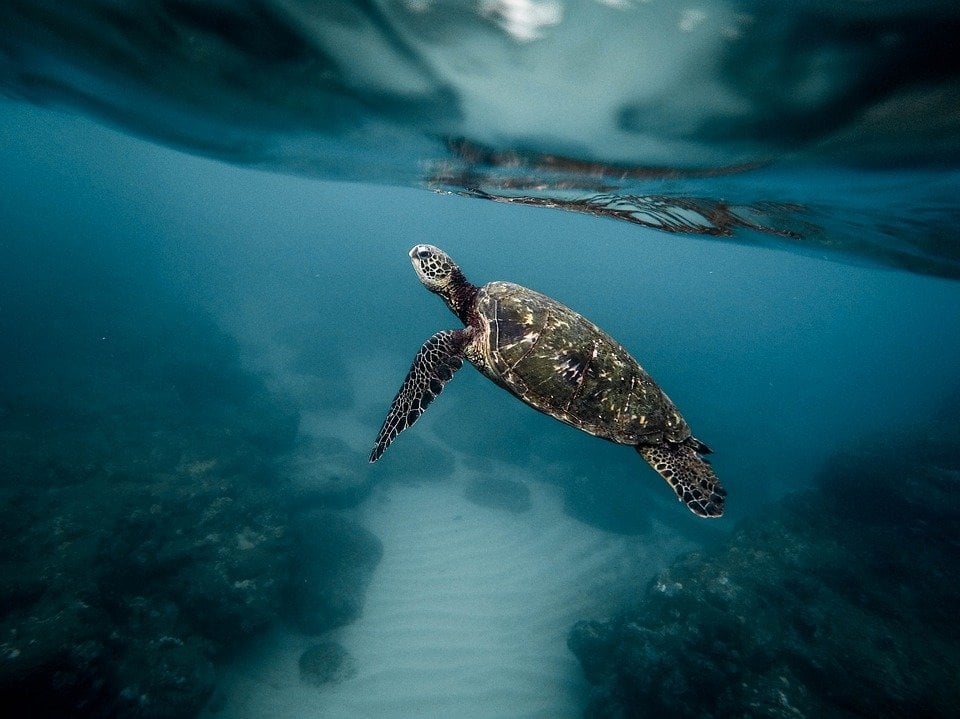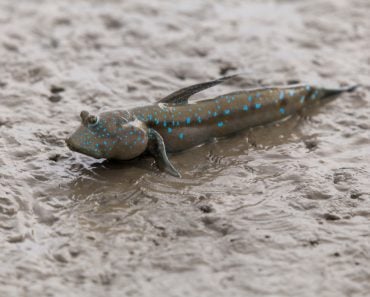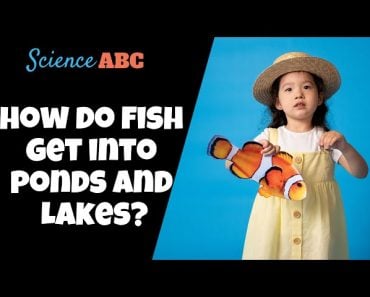Table of Contents (click to expand)
Turtles take in food through their mouth, firmly hold it between their tongue and the upper palate of their mouth and then expel the water out.
Turtles have been gliding through the Earth’s waters since long before humans were around to use these big brains of ours. These ancient and rather strange creatures are diverse; some live on land, others live a fully underwater lifestyle, while some turtles like to have the best of both worlds, surviving both on land and in water. However, these reptiles (not everything that lives in the water is a fish) face a problem that us land-dwelling folk don’t – how to eat without swallowing seawater?
Eating can’t be an easy thing underwater. Open your mouth to catch a tasty fish, and water rushes in. Thankfully, evolutionary phenomena pretty much ensure that organisms are well-adapted to live in their respective habitats and ecological niches. As such, all aquatic animals have some mechanism that allows them to feed without ingesting large amounts of water.
Recommended Video for you:
How Do Fish Eat Underwater?
Before we discuss how turtles go about eating without filling up with water, let’s talk about fish and how they manage to deal with water feeding.
For fish, those animals with gills, water is as good as air for us. Just as we never have to thinking about swallowing air when we eat, similarly, fish are perfectly adapted to life in the water.

Unlike animals with lungs, fish get their breathing and feeding done from a single opening. A fish opens its mouth, letting water inside. This oxygen-rich water is funneled toward the gills, the organ that allows fish to breathe. This oxygen-rich water passes over the gills, where capillaries with oxygen-deprived blood take in the oxygen from the water, which is then expelled from the gill flap.
In front of the gills are bony structures called gill rakers. These structures are like combs that filter the water for food like microscopic plankton or larger prey. This food is then shunted towards the esophagus, where the digestive process begins.

Just Spit It Out
There are seven marine or sea turtle species – the Loggerhead turtle, Kemp’s Ridley turtle, Olive Ridley turtle, Leatherback turtle, Green turtle, Hawksbill turtle, and the Flatback sea turtle. They spend their lives roaming the wild waters of the world, munching on algae, sea sponges, sea cucumbers and a lot jellyfish. Although they sleep and eat in the water, they need to surface from the water to breathe in air. With their oxygen replenished, they dive back down with the oxygen stored in their lungs. When the sea turtles venture out to eat, they restrict the entry of water into the trachea, similar to how we do when we eat or drink.

A sea turtle’s skull is well adapted to eating underwater without swallowing too much water. To eat, turtles rapidly extend their head and neck and literally suck the food and water into their mouth, somewhat like slurping noodles. The suction created also serves to keep prey inside the mouth. It does this by expanding the back of the throat, called the oropharyngeal cavity, as well as lowering the bottom of the throat by depressing a bone called the hypoid.
Once the food is within the mouth, the turtle expels the water they took in. They do this through two processes. The turtle will raise its tongue, immobilizing the prey between the tongue and the roof of its mouth. At the same time, it will compress its mouth, expelling the water through a slight gap between its mouth and nostrils. Scientists have observed that after turtles take in their prey, they release a jet of water from their nostrils and from these small gaps in their mouth.
All the water isn’t expelled, likely because the turtle requires that water for swallowing. Multiple investigations have noted that some turtles can’t swallow their food while on land, indicating that water plays a crucial role in this process.
One of the other possible reasons for this might be the salivary glands. Land animals have multiple types of salivary glands in our mouths, while those in turtles are reduced, or they only have one. This indicates that the gland might only function to release digestive enzymes, but doesn’t provide enough water lubrication to enable swallowing food from the mouth.
To swallow the food, the turtles expand the backs of their throat,
The food, now called the “bolus”, progresses down the esophagus. There are long conical projections called papillae oriented in the direction of the stomach that prevent the bolus from moving back into the mouth. This structure looks like a very bizarre tube with large inward-facing spikes.

These esophageal papillae also prevent the turtle from ingesting too much salty seawater. As the bolus (and with it, some water) moves down the esophagus, the papillae serve as a kind of filter, squeezing out the leftover water. The turtle can then expel the water, but the food doesn’t escape due to the inward-facing papillae.
Why Get Rid Of The Water?
Many sea turtles spend part of their time in salty ocean water. Drinking salty water every time the sea turtle tries to feed something would be disastrous. The salt water has a higher concentration of ions than the cells of the turtles, and therefore, due to osmosis, the excess ions would enter the cells and disturb the delicate balance required for the chemical environment of proteins and DNA in the cell.
To stay sufficiently hydrated, sea turtles don’t just drink salt water. They prefer to drink water that has a slightly lower mineral load, or freshwater. In a single drink, turtles can swallow an impressive amount of water that can last for quite a while. They also get a lot of their water content from the food they eat.
Life is magnificent. Look at any corner of the world and you will see that life has adjusted itself with the strangest and most mind-boggling adaptations.
In his book ‘The World Without Us’, the award-winning journalist Alan Weisman talks about what life would be like without humans. He writes “Let’s face it: who would’ve predicted the existence of turtles? Who would ever have imagined that an organism would essentially turn itself inside out, pulling its shoulder girdle inside its ribs to form a carapace? If turtles didn’t exist, no vertebrate biologist would’ve suggested that anything would do that: he’d have been laughed out of town. The only real prediction you can make is that life will go on. And that it will be interesting.”
References (click to expand)
- (1998) Kinematics of Aquatic and Terrestrial Prey Capture in .... The University of Washington
- Meet the Seven Sea Turtle Species | Smithsonian Ocean. The Smithsonian Institution
- Bels, V. L., Davenport, J., & Renous, S. (1995, July). Drinking and water expulsion in the diamondback turtle Malaclemys terrapin. Journal of Zoology. Wiley.
- Caillouet Jr, Charles. (1994). Hook and line bycatch of Kemp's ridley sea turtles (Lepidochelys kempii) along the Texas coast, 1980-1992. - ResearchGate
- Spotila, J. R.,& Santidrián T. P. (2015). The Leatherback Turtle: Biology and Conservation. Johns Hopkins University Press
- Lintner, M., Weissenbacher, A., & Heiss, E. (2012, September 28). The Oropharyngeal Morphology in the Semiaquatic Giant Asian Pond Turtle, Heosemys grandis, and Its Evolutionary Implications. (A. R. Evans, Ed.), PLoS ONE. Public Library of Science (PLoS).
- Perry S. F.,& Tufts B. L. (1998). Fish Respiration. Academic Press













